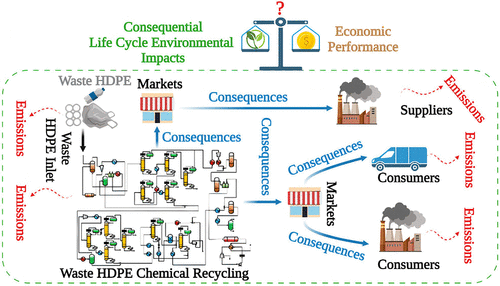当前位置:
X-MOL 学术
›
ACS Sustain. Chem. Eng.
›
论文详情
Our official English website, www.x-mol.net, welcomes your feedback! (Note: you will need to create a separate account there.)
Consequential Life Cycle Assessment and Optimization of High-Density Polyethylene Plastic Waste Chemical Recycling
ACS Sustainable Chemistry & Engineering ( IF 8.4 ) Pub Date : 2021-08-09 , DOI: 10.1021/acssuschemeng.1c03587 Xiang Zhao 1 , Fengqi You 1, 2
ACS Sustainable Chemistry & Engineering ( IF 8.4 ) Pub Date : 2021-08-09 , DOI: 10.1021/acssuschemeng.1c03587 Xiang Zhao 1 , Fengqi You 1, 2
Affiliation

|
This work develops a consequential life cycle optimization (CLCO) framework that integrates the superstructure optimization, consequential life cycle assessment (CLCA) approach, market equilibrium models, and techno-economic assessment methodology to determine the economically and environmentally optimal waste high-density polyethylene (HDPE) chemical recycling technology pathway, which manufactures chemical and energy products that cause market dynamics. System expansion in CLCA can quantify the environmental consequences of an increment of feedstock suppliers’ and downstream product consumers’ processes as well as a decrement of feedstock consumers’ and downstream product suppliers’ processes. These market dynamics are ignored when performing attributional life cycle assessment (ALCA). The CLCO problem is formulated as a multi-objective mixed-integer nonlinear fractional programming problem and solved by an optimization algorithm that integrates the inexact parametric algorithm and branch-and-refine algorithm. The environmental and economic objectives are minimizing the unit consequential life cycle environmental impacts and maximizing the unit net present value, respectively. Market dynamics results show that consuming natural gas in the waste HDPE chemical recycling process increases the natural gas’ market price and supply by 0.1%, while onsite manufacturing propylene decreases propylene market price by 5.46%, decreases propylene supply by 8.8%, and increases the propylene demand by 10.2%. Disparities and comprehensiveness are two effects of system expansion. Disparities are illustrated by a 14.22% decrease in greenhouse gas (GHG) emissions and a 60.37% reduction of photochemical oxidant formation compared to ALCA results. Comprehensiveness of system expansion is reflected by the diverse results of the environmental consequences of each consumer or marginal supplier’s process of feedstocks and products. Specifically, the substitution of 1-butene supplier’s process by onsite production from chemical recycling reduces 19.68% of total photochemical oxidant formation. Onsite use of natural gas from chemical recycling increases 37.14% of total ionizing radiation.
中文翻译:

高密度聚乙烯塑料废化学品回收的后续生命周期评估与优化
这项工作开发了一个后续生命周期优化 (CLCO) 框架,该框架集成了上部结构优化、后续生命周期评估 (CLCA) 方法、市场均衡模型和技术经济评估方法,以确定经济和环境最佳的废弃高密度聚乙烯。 HDPE) 化学回收技术途径,制造引起市场动态的化学和能源产品。CLCA 中的系统扩展可以量化原料供应商和下游产品消费者流程增加以及原料消费者和下游产品供应商流程减少的环境后果。在执行归因生命周期评估 (ALCA) 时,这些市场动态会被忽略。CLCO 问题被表述为多目标混合整数非线性分数规划问题,并通过集成不精确参数算法和分支和细化算法的优化算法解决。环境和经济目标分别是最小化单位后续生命周期环境影响和最大化单位净现值。市场动态结果表明,在废HDPE化学回收过程中消耗天然气使天然气的市场价格和供应量增加0.1%,而现场制造丙烯使丙烯市场价格下降5.46%,使丙烯供应量减少8.8%,并增加了天然气的市场价格和供应量。丙烯需求增长10.2%。差异性和综合性是系统扩展的两个效应。差异以 14 表示。与 ALCA 结果相比,温室气体 (GHG) 排放量减少了 22%,光化学氧化剂的形成减少了 60.37%。系统扩展的综合性通过每个消费者或边际供应商的原料和产品过程的环境后果的不同结果来反映。具体而言,通过化学回收的现场生产替代 1-丁烯供应商的工艺减少了总光化学氧化剂形成的 19.68%。化学回收天然气的现场使用增加了总电离辐射的 37.14%。具体而言,通过化学回收的现场生产替代 1-丁烯供应商的工艺减少了总光化学氧化剂形成的 19.68%。化学回收天然气的现场使用增加了总电离辐射的 37.14%。具体而言,通过化学回收的现场生产替代 1-丁烯供应商的工艺减少了总光化学氧化剂形成的 19.68%。化学回收天然气的现场使用增加了总电离辐射的 37.14%。
更新日期:2021-09-13
中文翻译:

高密度聚乙烯塑料废化学品回收的后续生命周期评估与优化
这项工作开发了一个后续生命周期优化 (CLCO) 框架,该框架集成了上部结构优化、后续生命周期评估 (CLCA) 方法、市场均衡模型和技术经济评估方法,以确定经济和环境最佳的废弃高密度聚乙烯。 HDPE) 化学回收技术途径,制造引起市场动态的化学和能源产品。CLCA 中的系统扩展可以量化原料供应商和下游产品消费者流程增加以及原料消费者和下游产品供应商流程减少的环境后果。在执行归因生命周期评估 (ALCA) 时,这些市场动态会被忽略。CLCO 问题被表述为多目标混合整数非线性分数规划问题,并通过集成不精确参数算法和分支和细化算法的优化算法解决。环境和经济目标分别是最小化单位后续生命周期环境影响和最大化单位净现值。市场动态结果表明,在废HDPE化学回收过程中消耗天然气使天然气的市场价格和供应量增加0.1%,而现场制造丙烯使丙烯市场价格下降5.46%,使丙烯供应量减少8.8%,并增加了天然气的市场价格和供应量。丙烯需求增长10.2%。差异性和综合性是系统扩展的两个效应。差异以 14 表示。与 ALCA 结果相比,温室气体 (GHG) 排放量减少了 22%,光化学氧化剂的形成减少了 60.37%。系统扩展的综合性通过每个消费者或边际供应商的原料和产品过程的环境后果的不同结果来反映。具体而言,通过化学回收的现场生产替代 1-丁烯供应商的工艺减少了总光化学氧化剂形成的 19.68%。化学回收天然气的现场使用增加了总电离辐射的 37.14%。具体而言,通过化学回收的现场生产替代 1-丁烯供应商的工艺减少了总光化学氧化剂形成的 19.68%。化学回收天然气的现场使用增加了总电离辐射的 37.14%。具体而言,通过化学回收的现场生产替代 1-丁烯供应商的工艺减少了总光化学氧化剂形成的 19.68%。化学回收天然气的现场使用增加了总电离辐射的 37.14%。


























 京公网安备 11010802027423号
京公网安备 11010802027423号